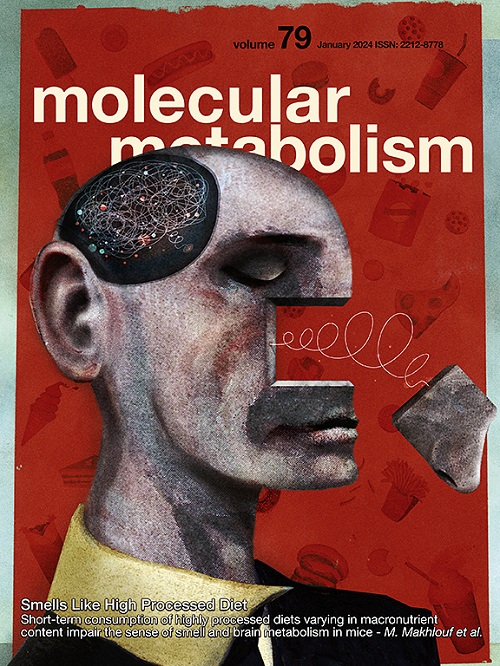Intestinal butyric acid-mediated disruption of gut hormone secretion and lipid metabolism in vasopressin receptor-deficient mice
IF 7
2区 医学
Q1 ENDOCRINOLOGY & METABOLISM
引用次数: 0
Abstract
Objectives
Arginine vasopressin (AVP), known as an antidiuretic hormone, is also crucial in metabolic homeostasis. Although AVP receptor-deficient mice exhibit various abnormalities in glucose and lipid metabolism, the mechanism underlying these symptoms remains unclear. This study aimed to explore the involvement of the gut hormones including glucagon-like peptide-1 (GLP-1) and microbiota as essential mediators.
Methods
We used the mouse GLP-1-secreting cell line, GLUTag, and performed live cell imaging to examine the contribution of V1a and V1b vasopressin receptors (V1aR and V1bR, respectively) to GLP-1 secretion. We next investigated the hormone dynamics of V1aR-deficient mice (V1aR−/− mice), V1bR-deficient mice (V1bR−/− mice), and V1aR/V1bR-double deficient mice (V1aR−/− V1bR−/−mice).
Results
AVP induced the increase in intracellular Ca2+ levels and GLP-1 secretion from GLUTag cells in a V1aR and V1bR-dependent manner. AVP receptor-deficient mice, particularly V1aR−/−V1bR−/− mice, demonstrated impaired secretion of GLP-1 and peptide YY secreted by enteroendocrine L cells. V1aR−/−V1bR−/−mice also exhibited abnormal lipid accumulation in the brown adipose tissue and skeletal muscle. We discovered that V1aR−/− V1bR−/− mice showed increased Paneth cell-related gene expression in the small intestine, which was attributed to increased fecal butyric acid levels. Exposure to butyric acid reduced GLP-1 secretion in L cell line. Additionally, human Paneth cell-related gene expressions negatively correlated with that of V1 receptor genes.
Conclusions
The deficiency in V1 receptor genes may increase gut butyric acid levels and impair the function of L cells, thus dysregulating lipid homeostasis in the brown adipose tissue and skeletal muscle. This study highlights the importance of appropriate control of the gut microbiota and its metabolites, including butyric acid, for the optimum functioning of enteroendocrine cells.
抗利尿激素受体缺乏小鼠肠道丁酸介导的肠道激素分泌和脂质代谢紊乱。
目的:精氨酸加压素(AVP)被称为抗利尿激素,在新陈代谢平衡中也至关重要。虽然 AVP 受体缺陷小鼠在葡萄糖和脂质代谢方面表现出各种异常,但这些症状的机制仍不清楚。本研究旨在探讨包括胰高血糖素样肽-1(GLP-1)在内的肠道激素和微生物群作为重要介质的参与:方法:我们使用小鼠 GLP-1 分泌细胞系 GLUTag 并进行活细胞成像,研究 V1a 和 V1b 加压素受体(分别为 V1aR 和 V1bR)对 GLP-1 分泌的贡献。我们接下来研究了V1aR缺陷小鼠(V1aR-/-小鼠)、V1bR缺陷小鼠(V1bR-/-小鼠)和V1aR/V1bR双重缺陷小鼠(V1aR-/-V1bR-/-小鼠)的激素动态:结果:AVP以V1aR和V1bR依赖的方式诱导细胞内Ca2+水平升高和GLUTag细胞分泌GLP-1。AVP受体缺陷小鼠,尤其是V1aR-/-V1bR-/-小鼠,肠内分泌L细胞分泌的GLP-1和肽YY的能力受损。V1aR-/-V1bR-/-小鼠的棕色脂肪组织和骨骼肌也表现出异常的脂质积累。我们发现,V1aR-/-V1bR-/-小鼠的小肠中与 Paneth 细胞相关的基因表达增加,这归因于粪便中丁酸水平的增加。暴露于丁酸会降低 L 细胞系的 GLP-1 分泌。此外,人类Paneth细胞相关基因的表达与V1受体基因的表达呈负相关:结论:V1 受体基因的缺乏可能会增加肠道丁酸水平,损害 L 细胞的功能,从而导致棕色脂肪组织和骨骼肌的脂质平衡失调。这项研究强调了适当控制肠道微生物群及其代谢产物(包括丁酸)对肠道内分泌细胞发挥最佳功能的重要性。
本文章由计算机程序翻译,如有差异,请以英文原文为准。
求助全文
约1分钟内获得全文
求助全文
来源期刊

Molecular Metabolism
ENDOCRINOLOGY & METABOLISM-
CiteScore
14.50
自引率
2.50%
发文量
219
审稿时长
43 days
期刊介绍:
Molecular Metabolism is a leading journal dedicated to sharing groundbreaking discoveries in the field of energy homeostasis and the underlying factors of metabolic disorders. These disorders include obesity, diabetes, cardiovascular disease, and cancer. Our journal focuses on publishing research driven by hypotheses and conducted to the highest standards, aiming to provide a mechanistic understanding of energy homeostasis-related behavior, physiology, and dysfunction.
We promote interdisciplinary science, covering a broad range of approaches from molecules to humans throughout the lifespan. Our goal is to contribute to transformative research in metabolism, which has the potential to revolutionize the field. By enabling progress in the prognosis, prevention, and ultimately the cure of metabolic disorders and their long-term complications, our journal seeks to better the future of health and well-being.
 求助内容:
求助内容: 应助结果提醒方式:
应助结果提醒方式:


